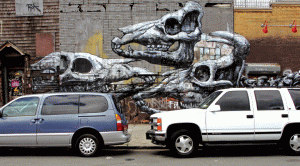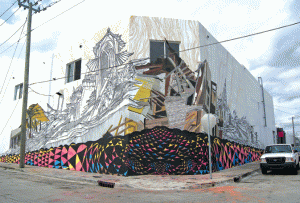« Features
How many of you saw the gorilla… or the return of mural painting?
The Strange Alliance between the Oldest and the Newest of all Media
History is always moving in unexpected ways. The paradox of the return of mural painting, the oldest of all media, in the era of the Internet and because of the Internet might well oblige us to change all of our parameters in reading art history. Is it possible that because of its exceptionality, painting is one of the most recognizable manifestations that you can find on the Net, and as such, is the only artistic medium around which it will be possible to create an audience?
By Nicola Verlato
In his most recent book, Richard Dawkins reports on an interesting experiment conducted by Professor Daniel J. Simons at the University of Illinois:
“Half a dozen young people standing in a circle were filmed for 25 seconds tossing a pair of basketballs to each other, and we, the experimental subjects, watch the film. The players weave in and out of the circle and change places as they pass and bounce the balls, so the scene is quite actively complicated. Before being shown the film, we are told that we have a task to perform, to test our powers of observation. We have to count the total number of times balls are passed from person to person. At the end of the test, the counts are duly written down, but - little does the audience know - this is not the real test!
After showing the film and collecting the counts, the experimenter drops his bombshell. ‘And how many of you saw the gorilla?’ The majority of the audience looks baffled: blank. The experimenter then replays the film, but this time tells the audience to watch in a relaxed fashion without trying to count anything. Amazingly, nine seconds into the film, a man in a gorilla suit strolls nonchalantly to the centre of the circle of players, pauses to face the camera, thumps his chest as if in belligerent contempt for eye-witness evidence, and then strolls off with the same insouciance as before.” (14-15)
Nobody sees the gorilla because they are too busy counting ball passes.
THE RADIO FOR IMAGES
What is this gorilla in the contemporary art scene that nobody is able to see? In the last 10 years, the Web has been invaded by images of all kinds, many of them paintings, drawings, graffiti, wheat paste art, stencils etc. Every painter, draftsman, or graffiti artist younger than 30 with an Internet connection has his or her own Web site or blog, and participates in forums and image exchanges through Twitter, Flickr, or even Facebook and other social networks. The Web seems to have become the radio for images.
Swoon, a graffiti artist, knows perfectly that her audience is not limited to the people that are walking the streets of Bushwick, where she pastes her images on the walls, or to the people that are gathering at the opening at the Deitch Projects. She knows that those events are just the tip of an iceberg whose giant submerged portion consists of the thousands of images that people view and download from the Web. She, as well as all the other artists present at the Graffiti Museum, can count on an enormous audience that supports their work on the Web. Galleries pay attention to this kind of widespread audience and may offer these artists the opportunity to show with them; for example, Jeffrey Deitch hired Shepard Fairey, an artist who was already a well-known legend on the Web.
THE GRAFFITI MUSEUM IN WYNWOOD
During the last art fair week in Miami, many of us had the opportunity to come in contact with this very interesting phenomenon, a phenomenon which has been moving in the artistic underground for quite a while, but that has never achieved major recognition in the official art system.
At the Graffiti Museum in the Wynwood District, Jeffrey Deitch offered one of the first opportunities to view many different graffiti styles in a common area, a sort of garden in which it was possible for visitors to enjoy these types of images without being bothered by the urban traffic that is usually connected with this kind of art. Rather than simple graffiti, these images were almost frescoes; the artists took the whole surface of the wall to create intricate compositions, showing a sort of virtuoso dominance of their medium of expression, whether mural paint, aerosol, or wheat paste.
One artist, Stelios Faitakis showed an interesting combination of traditional byzantine icon style and the urgency of narrative of a Panavision movie, demonstrating an amazing control of composition on such a large scale. Meanwhile, Shepard Fairey’s mural was an excellent example of his art (though it did not deviate much from the usual, he’s a necessary presence at an event like this.) Unfortunately, Swoon did not finish her ambitious undertaking; nevertheless, it was interesting to witness the spectacle that a work in progress of such titanic proportions presents.
Kenny Sharf’s painting reminded us of another era with a different approach to the media, a rougher conception of the image, seen more as a proof of existence of the artist himself instead of an image. His is a kind of a logo or signature, painting while running away from the police in the New York City of the 80s.
If the work of Kenny Sharf represents the old approach to graffiti, what exactly has changed between the old and new school? Why is the new “graffiti” more like big paintings than simple logos painted in a hurry?
It’s been at least 30 years that we’ve been talking about graffiti art. It has been sometimes exciting, sometimes boring, and other times we considered it pure vandalism.
What’s changed in the last 10 years that’s making us begin to be intrigued by this form of expression again?
TOWARDS A ‘DEMOCRACY’ OF THE VIEWER?
What I think is really changing due to this developing link between the arts and new media is the relationship between the various figures of the art system.
The artist is able to create his or her own notoriety even without gallery representation, which in this different kind of environment, is acquired later. This dynamic doesn’t create the artist ex nihilo as we have witnessed over and over again in the last 20 years. Instead, galleries are gathering art that has already won over the widespread audience of the web. This shift in the relationships between the figures of the system is obviously reflected in the language that generally these young artists are choosing for their work. The public, instead of art professionals, is the entity which is now determining the success of the artists, and the public is doing so through the web. It therefore seems almost obvious that the prevalent language is, 90 percent of the time, pop or figurative, and in the vast majority of these cases the media are paintings and drawings. It is basically the reverse of what would usually happen in the mainstream contemporary art system, which is an elitist social system where the artist is usually imposed upon by a very closed circuit of people (curator, gallerist and so on) on a more or less wider audience.
This reversion of the process of consensus can happen because of this alliance between new media (the Internet) and visual arts. Can we expect to witness the application of the same historicist evolutionary model to the artistic language of this new post-Facebook generation of artists, the same one which was applied to the arts of the last two centuries? I personally don’t think so. I think that a new approach to the arts will be needed for the years to come.
I also think that at this point it would be interesting to do a comparison with what happened in music the last 40 years. Who is still listening to Berio, Maderna, Stockhausen, Boulez, or even Xenakis? Of course, they still have an audience of aficionados, but they are no longer able to fill opera houses, as they did during the 1960s and 70s. What has happened to music that 30 years ago was considered the future of the musical language?
The answer is simple: a different kind of music was rising in the same period, with the help of a tight alliance between the record industry, the radio stations, and all the new audio media. The music of The Beatles, The Rolling Stones, Jimi Hendrix, Led Zeppelin, and so on was created in order to fit perfectly with the electronic media. It didn’t need the medium of a concert hall to be experienced, unlike Nono, who by the way, as late as the early 1980s managed to have a new theater planned by Renzo Piano, constructed within a church in Venice for his opera Prometeo, which was to be experienced in that specific space. The opera was unable to be experienced on the radio the same way it was experienced in the concert hall, and in that way it perished from our memory.
Can an installation be experienced on the web? Can the meaning of a video projection be understood on YouTube? Personally, I don’t think so. On the other hand, a mural by Doze Green or a painting by Robert Williams can be appreciated in a picture casually found through Twitter. This is what galleries like Jonathan Levine in New York or Merry Karnowsky in Los Angeles, and of course Jeffrey Deitch in New York, have understood for many years. The exhibitions in these galleries are much like live concerts: the audience gathers there to see in person something they have already seen on the Internet. The exhibitions create the opportunity to get in touch with the physicality of the image which was originally seen through a computer screen.
All of this despite the destiny of “[t]he work of art in the age of its technological reproducibility… ” (Benjamin).
WORKS CITED
Benjamin, Walter. The Work of Art in the Age of its Technological Reproducibility, and Other Writings on Media. Eds. Michael W. Jennings, Brigid Doherty, and Thomas Y. Levin. Boston: Belknap Press of Harvard University Press, 2008.
Dawkins, Richard. The Greatest Show on Earth: The Evidence for Evolution. New York: Free Press, 2009.
Nicola Verlato is an Italian painter and sculptor based in New York. He has exhibited his work internationally, mainly in Europe (Italy, Germany, Holland, Norway) and the United States, in public and private spaces such as Venice Biennale, Prague Biennale, Laguna Museum, MART, MACRO, Stux Gallery, Jonathan Levine Gallery. He is currently professor at New York Academy of Art.





































